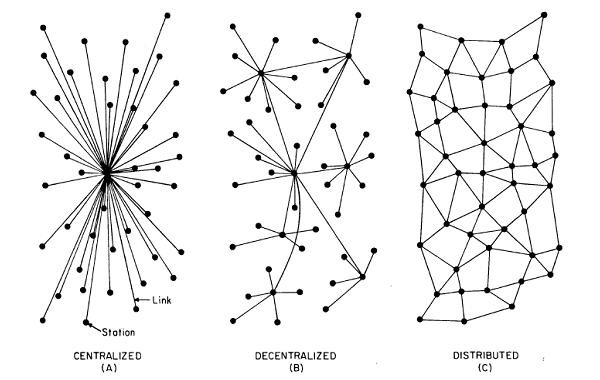Real decentralization is radical
by David Zetland (originally published at One handed economist)
Real decentralization is radical
Visionaries, consultants and public speakers love to explain how they are embracing distribution over decentralization over centralization, using an image like this:
What drives me crazy about this image is that it actually undersells true decentralization, i.e., when everyone is connected to everyone:
We already have such systems for email (anyone on Earth can connect with anyone else without going through a censor, “chokepoint,” or authority), and cryptocurrencies offer the same connectivity for money.
Note that mobile phones are not decentralized because they need to be connected to carriers, which also means that mobile phone apps for messaging and payment are not decentralized. (I can’t install WePay on my phone, for example, because it’s not approved for the EU.)
These distinctions are important to people who support freedom of action, belief and existence — freedoms that are under assault in Hong Kong, Iran, China, and even the US (due to monopoly concentrations and government attempts to control private conversation).
Thus, we need to avoid debating “decentralization” within an Overton window preferred by authorities and would-be-monopolies. Those parties are happy with figures B and C because they can be monitored and controlled via critical nodes such as influencers, service providers, or content owners.
My one-handed conclusion is that citizens should insist on real decentralization. Choose D.
H/T to CD



But, I really do want Kevin Bacon between me and The Dumpster®.
The internet is designed so it appears that each node is capable of connecting to any other node, but in practice traffic is routed through potential choke points. All of my home traffic goes through my ISP. When I worked at a major corporation, all of my traffic went through a connection to a major telecommunications provider. Even the original ARPANET had a limited number of wires connecting coast to coast.
As China has demonstrated, it is possible to build a firewall to limit connections within a region to a broad class of nodes outside that region. A user in Shanghai might not be able to access the Tianamen Square Wikipedia page, but they can access the backdoor to a US defense company’s internal network as a matter of policy. I suppose one could arrange for a satellite internet account, but this would require a way of laundering the funds and installing a hard to detect antenna.